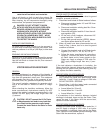
Section 1
GENERATOR FUNDAMENTALS
FIELD BOOST
When the engine is cranked during startup, the starter
contactor is energized closed. Battery voltage is then
delivered to the starter motor and the engine cranks.
During cranking, battery voltage flows through a resis-
tor and a field boost diode in the Printed Circuit Board,
then to the Rotor via brushes and slip rings. This is
called “Field Boost” voltage.
Field boost voltage is delivered to the Rotor only while
the engine is cranking. The effect is to “flash the field”
every time the engine is cranked. Field boost voltage
helps ensure that sufficient “pickup” voltage is avail-
able on every startup to turn the Voltage Regulator on
and build AC output voltage.
NOTE: Loss of the Field Boost function may or
may not result in loss of AC power winding output.
If Rotor residual magnetism alone is sufficient to
turn the Regulator on, loss of Field Boost may go
unnoticed. However, if residual magnetism alone
is not enough to turn the Regulator on, loss of the
Field Boost function will result in loss of AC power
winding output to the load. The AC output voltage
will then drop to a value commensurate with the
Rotor’s residual magnetism (about 7-12 VAC).
GENERATOR AC CONNECTION SYSTEM
These air-cooled generator sets are equipped with
dual stator AC power windings. These two stator wind-
ings supply electrical power to customer electrical
loads by means of a dual 2-wire connection system.
Generators may be installed to provide the following
outputs:
1. 120 VAC loads only — one load with a maximum
total wattage requirement equal to the generator’s
rated power output (in watts), and 120 VAC across
the generator output terminals. Figure 1-8, page
7, shows the generator lead wire connections for
120 VAC ONLY.
2. 120/240 VAC loads — one load with a maximum
total wattage requirement equal to the generator’s
rated power output, and 240 VAC across the gen-
erator output terminals; or two separate loads,
each with a maximum total wattage requirement
equal to half of the generator’s rated power out-
put (in watts), and 120 VAC across the generator
output terminals. Figure 1-9 on page 7, shows the
generator lead wire connections for 120/240 VAC
loads.
You can use your generator set to supply electrical
power for operating one of the following electrical
loads:
• RV45G&LP:120and/or240volts,singlephase,
60 Hz electrical loads. These loads can require up
to 4500 watts (4.5 kW) of total power, but cannot
exceed 45.8 AC amperes of current at 120 volts or
exceed 22.9 AC amperes at 240 volts.
• RV55G&LP:120and/or240volts,singlephase,
60 Hz electrical loads. These loads can require up
to 5500 watts (5.5 kW) of total power, but cannot
exceed 54.1 AC amperes of current at 120 volts or
exceed 27 AC amperes at 240 volts.
• RV65G&LP:120and/or240volts,singlephase,
60 Hz electrical loads. These loads can require up
to 6500 watts (6.5 kW) of total power, but cannot
exceed 62.5 AC amperes of current at 120 volts or
exceed 31.2 AC amperes at 240 volts.
*
Caution! Do not overload the generator. Some
installations may require that electrical loads
be alternated to avoid overloading. Applying
excessively high electrical loads may damage
the generator and may shorten its life. Add up
the rated watts of all electrical lighting, appli-
ance, tool and motor loads the generator will
power at one time. This total should not be
greater than the wattage capacity of the gen-
erator. If an electrical device nameplate gives
only volts and amps, multiply volts times
amps to obtain watts (volts x amps = watts).
Some electric motors require more watts of
power (or amps of current) for starting than
for continuous operation.
LINE BREAKERS (120 VOLTS ONLY):
Protects generator’s AC output circuit against
overload, i.e., prevents unit from exceeding wattage/
amperage capacity. The circuit breaker ratings are as
follows:
Model Cir. Breaker 1 Cir. Breaker 2 240 Volt
RV 45 20A 20A 20A 2P
RV 55 20A 30A 25A 2P
RV 65 30A 30A 30A 2P
Page 6


















